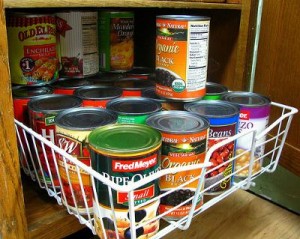FULL FRIDGE DOES NOT MEAN FULL BELLY: OUT OF THE BOX SENIOR FOOD OPTIONS
 A couple of weeks ago, I took off my lawyer hat and put on my daughter hat as my brother and I helped my almost-84 year old mom get through a sudden medical crisis. Mom is cognitively completely well, is financially stable, lives independently in a one-floor condo in a retirement community, still drives locally during the day, has a bunch of close friends, and is socially active. But she also has a bunch of chronic medical issues and mobility challenges. My brother and I both live several hours away, so as needed, she uses the services ofa local couple who help her with housekeeping, routine home maintenance tasks, grocery shopping, and driving long distances. We all worry because Mom has a decades-long history of multiple falls and resulting injuries, but generally speaking, she’s a senior success story. Except when she is not.
A couple of weeks ago, I took off my lawyer hat and put on my daughter hat as my brother and I helped my almost-84 year old mom get through a sudden medical crisis. Mom is cognitively completely well, is financially stable, lives independently in a one-floor condo in a retirement community, still drives locally during the day, has a bunch of close friends, and is socially active. But she also has a bunch of chronic medical issues and mobility challenges. My brother and I both live several hours away, so as needed, she uses the services ofa local couple who help her with housekeeping, routine home maintenance tasks, grocery shopping, and driving long distances. We all worry because Mom has a decades-long history of multiple falls and resulting injuries, but generally speaking, she’s a senior success story. Except when she is not.
Mom has always been a big grocery shopper, often buying for herself more than my brother or I buy for our families of four. That doesn’t mean though that she eats all of that food … it just means it is there, making her feel secure that she will be fine if she couldn’t get out, or people couldn’t come to help for awhile. She regularly bemoans how healthy her garbage can often is because of the amount of stuff that gets ditched because it goes bad before she can use it. Despite our best efforts, she has been doing this for decades and we have all been lulled into a false sense of security from seeing her fridge full. She has never been a huge cook, but she gets by. And if the fridge and cabinets are full, she must be eating well, right?
Well, maybe. Or maybe not. I have read many articles saying that empty refrigerators and cabinets are often red flags to children that their parents may be having some problems (nutritional, financial, cognitive). But I have never seen an article saying that a full kitchen could also be a red flag. Consider this post that article. We have now learned the importance of asking lots of questions despite appearances.
Because in Mom’s case, turns out that her full kitchen was masking the fact that for the past month or so, she hadn’t had much of an appetite and hadn’t been thirsty so she wasn’t eating or drinking very much or very well. Compound that with a new medication, not telling her doctor or us that she wasn’t feeling so well, and, shocker: she crashed and nearly burned. As in fatally burned. Fortunately, after some scary days, she rallied and is now back to her medical normal. But we have all agreed that we need to make sure that going forward, we have a plan in place so that she has easily accessible, appetite enticing, prepared (or easy to prepare) foods at hand so that she can continue to be well and remain independent at home.
For many seniors, one solution to these issues is signing up for the Meals on Wheels program. Serving over 2.5 millions seniors throughout the country, this program delivers nutritious meals (with the bonus of a daily safety check) to the senior’s home. Locally, more information about Meals on Wheels is available through the Councils on Aging. (See our Community Resources page for links to the local COAs.) Nutritious hot meals are also available at the Senior Centers for a nominal fee. Other seniors may benefit from a meeting with a registered dietician or nutritionist to help create healthy meal plans customized to the senior’s particular needs. Seniors with dental or swallowing or digestive issues that affect their ability to eat may need special help addressing their nutritional needs. Check out this blog post which gives some great practical solutions to senior nutrition issues: Google “simple meals for seniors” for more resources and suggestions.
For my mom, her mobility issues, diminished strength, and loss of height have made it difficult for herto reach or bend or lift or carry, all of which affect her ability to prepare meals. She can use the stove without any problem, but it is very hard for her to reach higher than the lowest cabinet shelf, or to put food in or out of the oven. She has horrible knives, so cutting things is a chore. And even in her younger days, she wasn’t pretending to be Martha Stewart. To address all of these issues, we came up with some solutions which are pretty simple, and ultimately will cost little more – and maybe even less – than what she has been spending on groceries up to now. They may not work forever, but they should work for now:
- We brainstormed the things that she particularly likes to make for breakfast and lunch, and made sure that she has the ingredients easily at hand. She likes to make eggs. So we bought already cut-up omelet ingredients, and made sure she has egg products in the house. She won’t/can’t cut up a bunch of veggies herself, but if they are in her fridge, already cut, she will happily use them.
- We brainstormed things that she might be able to make or order for dinners, which could also turn into leftovers for future meals. She is going to try (with our help if she wishes/needs) each week to come up with a list of dinner things she might like to eat over the coming week. Purchasing an already roasted chicken, some already cut-up squash, and a steamable bag of green beans, for example, gave her multiple meals for this coming week (plus some cranberry sauce, of course). (Google “rotisserie chicken”for all kinds of inspiration!)
- We talked about other “semi-homemade” meals that she could cook. For example, we reviewed “this side up” on frozen foods that can be microwaved in the bag. We confirmed that she knows how to use her microwave.
- Because she can’t lift things out of her oven, we looked at the website of a local caterer who might, for example, roast and package for her a turkey breast, or some other similar thing that could be the base for other meals.
- We identified which of her local grocery stores have an in-store salad bar which is not only a source for a great salad, but also for other already-cut up meal ingredients.
- We looked at the menus of her favorite local restaurants to identify which of them deliver (or might be convinced to deliver to her). Since restaurant portions are so big, one take out dinner will translate into several meals.
- We explored the grocery delivery services available in her area so she doesn’t have to rely on the availability of her shopping helpers. See, for example, PeaPod (www.peapod.com) which will end up being less expensive than paying her helper to shop for her!
- On my next visit, we are going to go through her kitchen to make sure that the utensils, knives, and other cooking tools and pantry basics that she needs for simple meal prep work well and are easily reachable so she can use them without it b
eing a chore. (Her knives are about to become history!) A senior might have the most amazing kitchenware, but if something is on too high a shelf, or too low in a cabinet stuffed behind a bunch of other things, it is never going to be used. If we make cooking as easy as possible, it is more likely that Mom will actually want to do it.
The end result of all of this (and I am sure there will be more ideas, including trying to use up at least some of the stockpiled stuff) is that Mom will probably
end up spending the same or maybe even less money each week on food, and will be eating healthier and better. Mom is willing to give all of it a try, and
we’ll see how it goes. These solutions probably won’t work forever, but they will hopefully carry her ahead for a long time to come.
For some families, the idea of using a caterer, or a delivery service, or getting take out one or two times a week or going out to purchase new cookware may seem unaffordable or extravagant. But compare these costs to the costs of assisted living … or a nursing home if poor nutrition causes the senior’s health to irrevocably decline. These are all examples of ways to maximize a senior’s resources. Spending a few extra dollars each week on these kinds of alternatives can help to stretch the time that a senior can remain independently at home, and beats the alternative of sticking with the status quo and ending up in the hospital (or worse) because of inadequate nutrition/hydration.
Bon Appetite!
